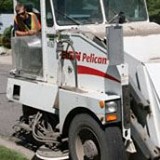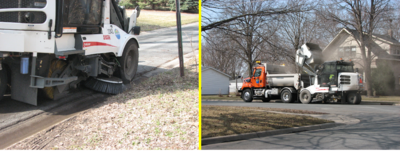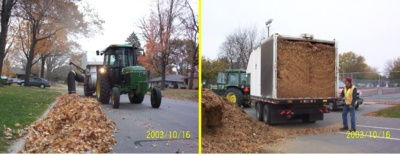
Difference between revisions of "Case studies for street sweeping"
| Line 119: | Line 119: | ||
|} | |} | ||
| − | [[File:Mankato sweeping picture.png| | + | [[File:Mankato sweeping picture.png|400px|thumb|alt=Mankato's leaf vacuum in action, and the resulting mulched leaves.|<font size=3>Mankato's leaf vacuum in action, and the resulting mulched leaves.</font size>]] |
Mankato’s water quality goals are to keep phosphorus, nitrogen, suspended solids, refuse and floatable debris out of the storm system to the extent possible. Mankato’s high priority areas are downtown, college campus areas, and due to their high pollutant loading, the older residential areas with a large tree canopy. Because Mankato is bordered by two major rivers (Minnesota River and Blue Earth River), both of which are subject to TMDLs, water quality and aesthetics have long been a priority. Sweeping activities are considered just as essential as snow plowing or mowing in the city. It keeps the city looking clean, the storm drains open and the ponds and rivers clean. Those benefits are clear and outweigh the cost. | Mankato’s water quality goals are to keep phosphorus, nitrogen, suspended solids, refuse and floatable debris out of the storm system to the extent possible. Mankato’s high priority areas are downtown, college campus areas, and due to their high pollutant loading, the older residential areas with a large tree canopy. Because Mankato is bordered by two major rivers (Minnesota River and Blue Earth River), both of which are subject to TMDLs, water quality and aesthetics have long been a priority. Sweeping activities are considered just as essential as snow plowing or mowing in the city. It keeps the city looking clean, the storm drains open and the ponds and rivers clean. Those benefits are clear and outweigh the cost. | ||
Revision as of 23:57, 1 January 2022
Street sweeping is an effective non-structural water quality best management practice for controlling pollutant loading from municipal road surfaces. Debris from road surface degradation and associated pollutants, leaf litter, and trash can accumulate on road surfaces over time. If not controlled, built-up debris will eventually make its way to storm sewer inlets and into the municipal separate storm sewer system (MS4), degrading water quality in receiving waterbodies.
This page provides case studies for street sweeping.
City of Roseville
The City of Roseville implemented a City-wide street sweeping program in 1990 which completed three to four sweeps a year. Since 2015, the City has completed four to five city-wide street sweeping operations over the course of a given year, targeting periods of street debris buildup associated with spring thaw (March-April), twice during fall leaf litter (October-November), and targeting areas of the City discharging to sensitive water resources. Street sweeping operations are organized by the City’s Streets Maintenance Department. On average, the City removes of 400 tons of material annually during initial spring sweeping operations and about 600 tons annually with all sweepings. The average cost to the City of spring sweeping operations is $46,000 and 440 hours of labor, with subsequent sweeps being significantly less expensive and requiring fewer labor hours.
A barrier encountered by the City early in development of their street sweeping program was related to material testing (i.e., when should collected street sweeping material be tested, how often, and what to do with contaminated materials). After years of operations, the City found the spring sweepings were almost always contaminated, primarily with diesel range organics. Due to the low cost-benefit of screening collected material and limited storage capacity for screened material, the City now ships and landfills all material collected during spring operations. Sweepings collected outside the spring season have not been considered contaminated.
More information regarding the City of Roseville’s street sweeping operations can be found on their municipal website, or by contacting Ryan Johnson, Environmental Specialist, City of Roseville Engineering Department (Ryan.Johnson@cityofroseville.com).
- Project Location: City of Roseville
- Completion Date: 1990 to Present (Ongoing)
- Organizations Involved: City of Roseville Streets Maintenance Department
- Project Budget Summary: Annual cost / hours for Spring street sweeping operations: $46,000, 440 labor hours
- Quantitative Outcomes: An average of 400 tons of debris is collected during spring sweeping operations each year. Using the MPCA street sweeping calculator and assuming an average moisture content of 27.8%, this equates to 238 pounds of phosphorus removed at a cost of $193/lb-P for the spring sweeping.
City of Lakeville – Using sweepers in tandem along with education and outreach to address their rapidly growing city
| Summary information | |
| City size (square miles) | 37.8 |
| City population (2020) | 69,490 |
| Number and Type of Sweepers Owned by the City | 2 mechanical and 1 vacuum (replaced every 10 years) |
| Does the City Use Contractors for Sweeping? | No |
| Curb Miles (either owned or managed by the City) | 600 lane miles |
| Miles Swept Annually | 1,200 lane miles |
| Frequency of Sweeping | Spring and Fall |
| Disposal | After materials are gathered, they are stockpiled, tested, and then hauled to the landfill. The fall leaves are composted. The amount of fall compost is more than what the city needs. The city is exploring uses for extra material. |
| Annual Sweeping Costs | $246,000 |
| Funding Source | General fund and the stormwater utility fee |
Lakeville is a rapidly developing community in the Minneapolis-St Paul Metro Area and is adapting to changing needs related to street sweeping. Lakeville currently sweeps in the spring and the fall, focusing on the older parts of the community with more mature trees and in areas close to streams and lakes. The city also deploys sweepers following large storm events.
Lakeville begins spring sweeping activities as soon as the gutters are free of snow and ice. Each of the sweepers are equipped with GPS technology, which the city uses to track areas of high-frequency sweeping. In the fall, the city prioritizes leaf pickup based on the species of the old growth trees and when they drop their leaves. Staff move to other locations as priority areas are completed, visiting all city streets two to three times in the fall months. Staff spend approximately 600 hours sweeping during the fall season. In the spring, all three sweepers are used throughout the city multiple times for a total of 900 staff hours. The mechanical and vacuum sweepers are run in tandem in heavy debris areas, with the mechanical sweeper collecting larger debris and vegetation while the vacuum sweeper removes salt and dirt.
Education and Outreach for Residents and City Staff
Lakeville communicates the importance of street sweeping to city residents through educational segments (written and filmed) in social media postings on Facebook, NextDoor, Twitter and the city’s YouTube channel. The Adopt-a-Drain and storm drain stenciling programs are also promoted on these platforms and at local community outreach events. The Adopt-a-Drain program and associated door hangers educate residents to avoid discarding their leaves and grass clippings into the street and encourages residents to do their part cleaning neighborhood storm drains. Lakeville directs city residents to use local waste haulers or the Mulch Store in Burnsville for yard debris disposal.
The Streets, Parks and Utilities departments have an annual meeting in the spring where they provide ongoing training and education to staff about the importance of sweeping, illicit discharges, erosion control, and good housekeeping concepts.
Lessons Learned and Advice
- Tree Inventory: Lakeville recommends conducting a tree inventory to more easily predict leaf drop and spring budding and determine where sweepers will be needed.
- Costs: Don’t neglect to include disposal costs in overall programmatic costs.
- Plan Accordingly: What you put down in the winter (i.e., sand) you’ll need to pick-up in the spring. Lakeville has eliminated use of sand for winter road maintenance and credits this with reduced phosphorus loading, less material on the roads in the spring, and less required maintenance.
Contact Information
- Kelly Perrine, Environmental Resources Specialist, Kelly Perrine
- McKenzie (Mac) Cafferty, Environmental Resources Manager, McKenzie Mac Cafferty
- City of Lakeville Street Sweeping Program
City of Mankato – Providing Multiple Leaf Disposal Options for Residents
| Summary information | |
| City Size (square miles) | 20.14 |
| City Population (2020) | 44,488 |
| Number and Type of Sweepers Owned by the City | 3 sweepers and 3 leaf vacuums: 2 Elgin Pelicans (mechanical), 1 Elgin Road Wizard (mechanical), 3 ODB leaf vacuums. Replacement schedule is 10-12 years. |
| Does the City Use Contractors for Sweeping? | No |
| Lane Miles (either owned or managed by the City) | 583.76 lane miles, including alleys |
| Miles Swept Annually | 11,814 miles (2021) |
| Frequency of Sweeping The entire city (all paved roads and alleys) is swept every 30 days during the sweeping season. Mankato sweeps major areas such as the downtown area once a week primarily for trash. | |
| Disposal | Materials are screened and the majority are composted. The city makes and uses their own compost from the leaves. Items that can’t be composted are used as top cover at the landfill (note – the landfill does not charge the city for this material). They also send material to a local composting site. |
| Annual Sweeping Costs | Street sweeping budget: $250-300K/year |
| Leaf pickup budget | $150-200K/year |
| Total costs (average approximately) | $400K/year |
| Funding Source | General fund for the purchase and maintenance of the sweepers. The existing residential and commercial utility rates support the current leaf vacuum collection throughout the city of Mankato. |
Mankato’s water quality goals are to keep phosphorus, nitrogen, suspended solids, refuse and floatable debris out of the storm system to the extent possible. Mankato’s high priority areas are downtown, college campus areas, and due to their high pollutant loading, the older residential areas with a large tree canopy. Because Mankato is bordered by two major rivers (Minnesota River and Blue Earth River), both of which are subject to TMDLs, water quality and aesthetics have long been a priority. Sweeping activities are considered just as essential as snow plowing or mowing in the city. It keeps the city looking clean, the storm drains open and the ponds and rivers clean. Those benefits are clear and outweigh the cost.
Mankato sweeps their streets throughout the non-frozen months, averaging one full city sweep every 30 days. Sweeping activities are tracked using GPS. Mankato currently weighs their sweeper loads and is utilizing the MPCA’s Street Sweeping Phosphorus Credit Calculator. In 2021, the city collected 1,185.79 tons of sweepings and 7,575 cubic yards of leaves (approximately 1,515 tons). In addition to city streets and alleys, Mankato partners with MnDOT and the county to also sweep those roads in the city limits.
The city of Mankato provides three options to residents each year to dispose of yard waste, including fall leaves:
- City-owned leaf vacuum collection conducted in the fall along all Mankato residential streets at no additional cost.
- Private composting site, at no additional cost for Mankato residents to drop off compostable material.
- Curbside pick-up for an extra cost through a private contractor.
Mankato encourages residents to rake their leaves into the street during a specified window in the fall. The three leaf vacuums run 12+ hours a day in the fall to conduct complete leaf clean-up. The city has found that raking the leaves into the street is more efficient because the citizens are more likely to do it if they don’t have to bag and haul them. Also, the high-powered vacuums will be going by to clean the streets anyway and they cause less damage and are more effective vacuuming leaves off the pavement.
Fall leaf pick-up with the leaf vacuums generally begins when the majority of leaves are on the ground and runs for approximately four weeks. The city forester helps determine when the city should begin leaf collection based on the tree canopy species. The leaf vacuum removes leaves and then chops and compacts them in a self‐contained unit. The chopped, compacted leaves are then composted.
Mankato has 25 people trained to operate the equipment. With so many staff trained, the crews are always out on the road giving them the opportunity to identify illicit discharges such as spills, leaks, garbage, and illegal dumping. In addition, the street crews have spill and drop kits to begin the clean-up process immediately. The kits give the staff time to call for assistance.
Future Opportunities
- Mankato plans to continue to educate the citizens more about water quality and street sweeping.
- Mankato plans to continue to expand the street sweeping program to help reach their TMDL goals.
Lessons Learned and Advice
- Broken Window Theory: The constant presence of sweepers and the watchful eyes of the operators helps control vandalism of city infrastructure, illegal refuse disposal, and illicit discharges. City of Mankato sweeper operators catch a majority of reported illicit discharges.
- Median and Street Washing/ Sweeping: The MS4 permit requirements helped Mankato to reinvent the process of cleaning medians, sidewalks, and bridges. The city used to use water to wash debris from these areas onto the road that would then be swept. To save water and reduce sediment and debris from making its way to catch basins, the city bought a broom attachment for their bobcat to instead push the material onto the road and then sweep it up, allowing for better material recovery and no additional runoff. This process was improved by putting the challenge of meeting MS4 compliance to the operators who know the roads and issues the best. The result was a faster, better sweeping process that was compliant with the MS4 requirements.
- Communication is Key: Cities should also communicate with residents. More knowledge equals less complaints.
- Buy Wisely: Testing equipment prior to purchase is critical, especially in hilly areas and areas that are hard to reach (e.g., narrow alleys).
- Valuing Expertise: Cities should be flexible with the operators because they are the experts. Work with your operators because they can figure out a better way and are able to think outside the box.
Contact Information
- Rick Baird, Environmental Sustainability Coordinator, Rick Baird
- City of Mankato Street Sweeping and Leaf Pickup Program



